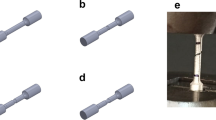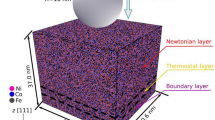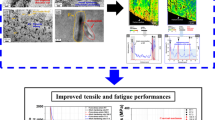Abstract
A model found by finite element method was developed in COMSOL Multiphysics to describe the evolution of residual stress after quenching of cylindrical samples of aluminium alloys AA2014 and AA5083. The treatment consisted of annealing followed by quenching in fresh water. The thermal and mechanical properties of both alloys at the annealing and room temperatures were taken into account. A different sample size was considered for each alloy. The simulations show that the residual stress strongly depends on the yield stress and sample size. The results obtained by the finite element method were compared with the experimental residual stress profiles calculated from neutron and X-ray diffraction data.




Similar content being viewed by others
REFERENCES
A. M. Korsunsky, A Teaching Essay on Residual Stresses and Eigenstrains (Butterworth-Heinemann, Oxford, 2017).
R. Fernández, S. Ferreira-Barragáns, J. Ibáñez, and G. González-Doncel, Mater. Des. 137, 117 (2018).
N. D. Ghetiya and K. M. Patel, Indian J. Eng. Mater. Sci. 22, 133 (2015).
N. Z. Khan, A. N. Siddiquee, Z. A. Khanm, and S. K. Shihab, J. Alloys Compd. 648, 360 (2015).
P. Hidnert and H. S. Krider, J. Res. Natl. Bur. Stand. (U. S.). 2308, 209 (1952).
B. Xiao, Q. Wang, P. Jadhav, and K. Li, J. Mater. Process. Technol. 210, 2023 (2010).
N. P. H. Chobaut, Thesis. Measurements and Modelling of Residual Stresses During Quenching of Thick Heat Treatable Aluminium Components in Relation to their Precipitation State (École Polytechnique Fédérale, Lausanne, 2015).
P. T. Summers, P. T. Summers, C. M. Rippe, B. Allen, A. P. Mouritz, S. W. Case, and B. Y. Lattimer, Fire Sci. Rev. 4, 2 (2015).
Q. Wen, W. Li, W. Wang, F. Wang, Y. Gao, and V. Patel, J. Mater. Sci. Technol. 35, 192 (2019).
Y. Chen, A. Clausen, O. Hopperstad, and M. Langseth, Int. J. Solids Struct. 46, 3825 (2009).
L. Millán, G. Bokuchava, R. Fernández, I. Papushkin, and G. González-Doncel. J. Alloys Compd. 861 (2021).
FUNDING
This work was supported by the Madrid’s Community (project Y2018/NMT-4668 Micro-Stress-MAP-CM) and the Ministry of Science and Innovation of Spain (project MAT2017-83825-C4-1-R). Neutron and synchrotron diffraction data were obtained in collaboration with the Frank Laboratory of Neutron Physics (Dubna, Russia) and the BESSY II synchrotron at the Helmholtz Zentrum. COMSOL software was provided by the Spanish National Research Council, C.S.I.C.
Author information
Authors and Affiliations
Corresponding author
Rights and permissions
About this article
Cite this article
Carro-Sevillano, G., Fernández, R., Bokuchava, G. et al. Residual Stress Distribution after Quenching Treatment Obtained from Diffraction Experiments and Simulation by Finite Element Method. J. Surf. Investig. 15, 537–541 (2021). https://doi.org/10.1134/S1027451021030071
Received:
Revised:
Accepted:
Published:
Issue Date:
DOI: https://doi.org/10.1134/S1027451021030071




